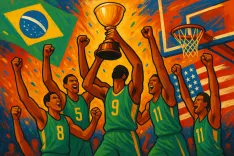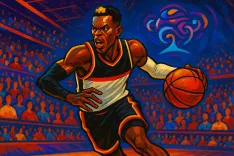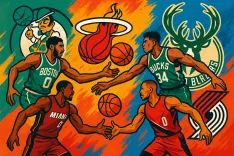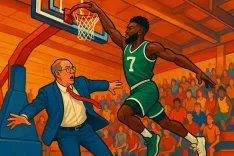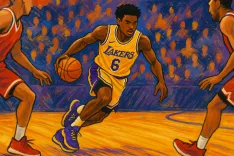NBA Playoffs 2025: A Shift in the Landscape

As the NBA Finals of 2025 approach, the playoffs have already delivered weeks of impressive highlights, competitive series, and standout performances that reflect the current state of the league. Despite memorable moments still on the horizon, a significant amount has already transpired, warranting an analysis through the lens of 'winners and losers.' The post-merger history of the NBA, which spans nearly five decades, has witnessed powerhouse franchises such as the Boston Celtics, Chicago Bulls, Golden State Warriors, Los Angeles Lakers, and Philadelphia 76ers collectively making 43 Finals appearances. This season, however, saw notable absences among these teams, as Philadelphia and Chicago did not reach the playoffs, the Lakers were eliminated in the first round, and both Golden State and Boston were ousted in the second round. The New York Knicks, representing the league's largest media market, made it to the conference finals but were also sent home. Unlike the NFL, which has enjoyed a reputation for parity, the NBA has long been synonymous with dynasties and storied franchises taking center stage during the postseason. The 2025 Finals, featuring the Indiana Pacers and Oklahoma City Thunder from smaller markets, signifies a departure from this tradition.
A prevailing philosophy in the league suggests that having the best player can often dictate a series' outcome. Owen Phillips, a commentator on basketball analytics, emphasizes that while basketball is characterized as a 'strong link sport'—where the team with the best player often prevails—in reality, weak links can heavily influence playoff results. As teams advance in the postseason, defensive liabilities or underperforming players can significantly hinder a squad's overall success. Phillips articulates that in high-pressure situations, poor defenders are mercilessly targeted, and players who hesitate to shoot are often ignored, creating disadvantages during critical moments. This theory underscores the increasing value of team depth, as exemplified by the Thunder and Pacers, both of which have displayed remarkable rotation depth throughout the playoffs without exposing weak links in their lineups. Moving forward, teams that invest heavily in superstars while neglecting depth may find themselves vulnerable.
Superstars LeBron James and Stephen Curry have defined the league across various promotional narratives, with James making ten Finals appearances and Curry six. However, the 2025 season illustrated their diminishing threat, as both players did not advance into contention. Accompanying them, contemporary stars such as Kevin Durant and Chris Paul also missed the playoffs, while others, including Damian Lillard, James Harden, and Kawhi Leonard, were eliminated in earlier rounds. The arrival of younger talents like Shai Gilgeous-Alexander and Anthony Edwards suggests that the league is winding down one era while potentially ushering in another. With the success of young teams and the possible decline of established stars, the narrative of basketball mortality becomes increasingly salient for James, Curry, and their contemporaries. As history indicates, the league consistently produces emerging stars ready to take the reins. Shai Gilgeous-Alexander, who is just 27, has shone in the current postseason alongside promising teammates Jalen Williams, Anthony Edwards, and Tyrese Haliburton—all of whom are still on the upward trajectory of their careers. Several influential players, such as Giannis Antetokounmpo and Nikola Jokić, have also entered their early 30s, creating a competitive environment ripe for the emergence of new talent eager to leave their mark.
Despite the ongoing debates surrounding the length of the regular season, some fans and analysts continue to advocate for maintaining the traditional 82-game format. The rigor and challenge of enduring a full season followed by a deep playoff run have long been central tenets of competitive basketball. Consequently, while records for single-season accomplishments may not be as prominently celebrated as in other sports, they still hold significance. Proponents of this view express concern that altering the regular season could compromise historical benchmarks, such as Curry's single-season three-point record or LeBron's career scoring total. Nonetheless, the injury concerns arising from a rigorous schedule, as evidenced by the postseason injury woes affecting players such as Jayson Tatum and Lillard, have led to more support for a reduced season. A more condensed schedule could potentially yield healthier players and foster increased competitiveness in both the regular season and playoffs, thereby justifying short-term financial losses as a trade-off for long-term gains.
One noteworthy element that surfaced during the current playoffs was the effect of the in-season tournament, introduced in recent years. The Indiana Pacers, who finished second in the inaugural tournament, along with the Oklahoma City Thunder, were able to translate that experience into their successful playoff campaigns. The heightened competitiveness of this tournament could potentially translate into a motivational boost, as these younger teams have demonstrated more determination in the playoffs after experiencing the pressure of tournament failures. Despite injuries impacting performance, the Cleveland Cavaliers emerged as one of the postseason's disappointments. Despite achieving a remarkable 64-18 record, the Cavaliers faltered against the Pacers in a surprising five-game series. Questions surrounding the effectiveness of their backcourt pairing of Donovan Mitchell and Darius Garland, in conjunction with the frontcourt duo of Jarrett Allen and Evan Mobley, loom large as they consider potential roster changes.
The Indiana Pacers, who faced initial skepticism after a surprising run to the conference finals in 2024, have demonstrated remarkable growth through patience and the successful integration of Pascal Siakam into their lineup. Rather than make impulsive changes following their previous postseason exit, the Pacers maintained their strategies and found their rhythm, allowing Haliburton and Siakam to lead them effectively to the Finals. By emphasizing the value of team depth and fluid ball movement, the Pacers not only challenged preconceived notions of playoff basketball but also demonstrated the power of active player involvement on both ends of the floor. Haliburton has notably countered his previous reputation as 'overrated,' while Siakam added an Eastern Conference Finals MVP to his resume. With significant contributions from role players such as Aaron Nesmith and Andrew Nembhard, the Pacers have emerged as undeniable winners of this postseason.
In contrast, the Denver Nuggets' postseason experience was marred by early exits and management changes. Despite a strong regular season and boasting a dominant player in Nikola Jokić, the Nuggets' early second-round departure has prompted discussions surrounding potential roster upheaval. Their battle against the Thunder further showcased Jokić's prowess, evident in his impressive averages of 28.4 points, 13.9 rebounds, and 5.9 assists during the series. Although they faced elimination, the Nuggets' competitive spirit against a formidable Thunder team indicated a promising future. As calls for dramatic roster changes circulate, minor adjustments may be more strategically beneficial for the franchise moving forward. The Oklahoma City Thunder's playoff run has been characterized by dominance, with them setting records for average point differential and total victories. Possessing a deep roster featuring MVP Shai Gilgeous-Alexander, the Thunder are positioned as favorites to win the Finals, reinforcing their status as the postseason's standout team.


